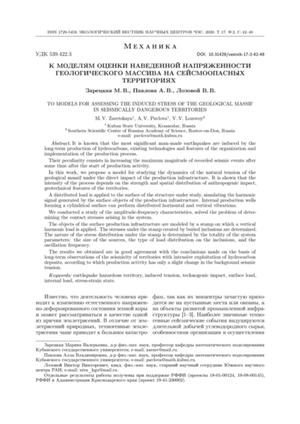К моделям оценки наведенной напряженности геологического массива на сейсмоопасных территориях
УДК
539.422.3DOI:
https://doi.org/10.31429/vestnik-17-2-42-48Аннотация
В настоящей работе предложена модель исследования динамики естественной напряженности геологического массива при непосредственном воздействии производственной инфраструктуры. Показано, что интенсивность процесса зависит от силы и пространственного распределения техногенного воздействия, инженерно-геологических особенностей территорий. На поверхность исследуемой структуры подается распределенная нагрузка, моделирующая гармонический сигнал, генерируемый поверхностными объектами производственной инфраструктуры. Внутренние эксплуатационные скважины, образующие цилиндрическую поверхность, могут совершать распределенные горизонтальные и вертикальные колебания. Проведено исследование амплитудно-частотных характеристик, решена задача определения контактных напряжений, возникающих в системе. Моделируя объекты поверхностной производственной инфраструктуры штампом, на который подается вертикальная гармоническая нагрузка, определены напряжения под штампом, создаваемые заглубленными включениями. Характер распределения напряжений под штампом определяется совокупностью параметров системы: размерами источников, видом распределения нагрузки на включениях и частотой колебаний.
Ключевые слова:
сейсмоопасная территория, индуцированная напряженность, техногенное воздействие, поверхностная нагрузка, внутренняя нагрузка, напряженно-деформированное состояниеИнформация о финансировании
Отдельные результаты работы получены при поддержке РФФИ (проекты 18-01-00124, 19-08-00145), РФФИ и Администрации Краснодарского края (проект 19-41-230002).
Библиографические ссылки
- Адушкин В.В., Турунтаев С.Б. Техногенная сейсмичность – индуцированная и триггерная. М.: ИДГ РАН, 2015. 364 с. [Adushkin V.V., Turuntayev S.B. Tekhnogennaya seysmichnost' – indutsirovannaya i triggernaya [Technogenic seismicity – induced and trigger]. IDG RAN, Moscow. (In Russian)]
- Адушкин В.В., Турунтаев С.Б. Техногенные процессы в земной коре (опасные и катастрофические) М.: ИНЭК, 2005. 252 с. [Adushkin V.V., Turuntayev S.B. Tekhnogennyye protsessy v zemnoy kore (opasnyye i katastroficheskiye) [Technogenic processes in the earth's crust (dangerous and catastrophic)]. INEK, Moscow, 2005. (In Russian)]
- Сибгатулин В.Г., Симонов К.В., Перетокин С.А. Оценка сейсмической опасности юга Центральной Сибири. Красноярск: КНИИГиМС, 2014. 194 с. [Sibgatulin V.G., Simonov K.V., Peretokin S.A. Otsenka seysmicheskoy opasnosti yuga Tsentral'noy Sibiri [Seismic hazard assessment of the south of Central Siberia.]. KNIIGiMS, Krasnoyarsk, 2014. (In Russian)]
- McGarr A., Simpson D., Seeber L. Case Histories of Induced and Triggered Seismicity // International Handbook of Earthquake and Engineering Seismology, Part A. London: Academic Press, 2002. P. 647–661.
- Suckale J. Induced seismicity in hydrocarbon fields // Advances in Geophysics. 2009. Vol. 51. P. 55–106.
- Hallo M., Oprsal I., Eisner L., Ali M.Y. Prediction of magnitude of the largest potentially induced seismic event // J. of Seismology. 2014. Vol. 18. Iss. 3. P. 421–431.
- Маловичко А.А., Маловичко Д.А. Применение методов численного моделирования сейсмических волновых полей для изучения разномасштабных проявлений техногенной сейсмичности // Современные математические и геологические модели природной среды: Сборник научных трудов. М.: ОИФЗ РАН, 2002. С. 120–138. [Malovichko A.A., Malovichko D.A. Primeneniye metodov chislennogo modelirovaniya seysmicheskikh volnovykh poley dlya izucheniya raznomasshtabnykh proyavleniy tekhnogennoy seysmichnosti [The use of methods for the numerical simulation of seismic wave fields to study different-scale manifestations of technogenic seismicity]. Sovremennyye matematicheskiye i geologicheskiye modeli prirodnoy sredy: Sbornik nauchnykh trudov [Modern mathematical and geological models of the environment: Collection of scientific papers]. Moscow, Izdatelstvo: OIFZ RAN, 2002, pp. 120–138. (In Russian)]
- Muir Wood D., Hu W., Nash D.F.T. Group effects in stone column foundations: model tests // Geotechnique. 2000. Vol. 50. Iss. 6. P. 689–698.
- Ambily A.P., Gandhi S.R. Behaviour of stone columns based on experimental and FEM analysis // Journal of Geotechnical and Geoenvironmental Engineering. 2007. Vol. 133. Iss. 4. P. 405–415.
- Павлова А.В., Капустин М.С., Зарецкая М.В., Телятников И.С. Моделирование напряженно-деформированного состояния неоднородных геоматериалов при вибрационных воздействиях // Защита окружающей среды в нефтегазовом комплексе. 2018. № 4. С. 48–54. [Pavlova A.V., Kapustin M.S., Zaretskaya M.V., Telyatnikov I.S. Modelirovaniye napryazhenno-deformirovannogo sostoyaniya neodnorodnykh geomaterialov pri vibratsionnykh vozdeystviyakh [Modeling of the stress-strain state of heterogeneous geomaterials under vibrational influences]. Zashchita okruzhayushchey sredy v neftegazovom komplekse [Environmental protection in the oil and gas complex], 2018, no. 4, pp. 48–54. (In Russian)]
- Павлова А.В., Зарецкая М.В., Капустин М.С., Лозовой В.В. К исследованию волновых процессов в блочной структуре вулканической постройки // Экологический вестник научных центров Черноморского экономического сотрудничества. 2019. Т. 16. № 2. С. 30–37. [Pavlova A.V., Zaretskaya M.V., Kapustin M.S., Lozovoy V.V. K issledovaniyu volnovykh protsessov v blochnoy strukture vulkanicheskoy postroyki [To the study of wave processes in the block structure of a volcanic structure]. Ekologicheskiy vestnik nauchnykh tsentrov Chernomorskogo ekonomicheskogo sotrudnichestva [Ecological Bulletin of Scientific Centers of the Black Sea Economic Cooperation], 2019. vol. 16, no. 2, pp. 30–37. (In Russian)]
- Пряхина О.Д., Смирнова А.В., Евдокимов А.А., Капустин М.С. Колебания полупространства при наличии системы жестких включений // ДАН. 2003. Т. 389. Вып. 1. С. 193–196. [Pryakhina O.D., Smirnova A.V., Yevdokimov A.A., Kapustin M.S. Kolebaniya poluprostranstva pri nalichii sistemy zhestkikh vklyucheniy [Half-space oscillations in the presence of a system of rigid inclusions]. Doklady akademii nauk [Rep. of the Academy of Sciences], 2003, vol. 389, iss. 1, pp. 193–196. (In Russian)]
- Капустин М.С., Павлова А.В., Рубцов С.Е., Телятников И.С. К моделированию взаимодействия фундамента с деформируемой грунтовой средой // Экологический вестник научных центров Черноморского экономического сотрудничества. 2015. № 3. С. 44–51. [Kapustin M.S. , Pavlova A.V., Rubtsov S.Ye., Telyatnikov I.S. K modelirovaniyu vzaimodeystviya fundamenta s deformiruyemoy gruntovoy sredoy [To modeling the interaction of the foundation with a deformable soil environment]. Ekologicheskiy vestnik nauchnykh tsentrov Chernomorskogo ekonomicheskogo sotrudnichestva [Ecological Bulletin of Scientific Centers of the Black Sea Economic Cooperation], 2015, no. 3, pp. 44–51. (In Russian)]
- Kapustin M., Pavlova A., Rubtsov S., Telyatnikov I. Model of foundation-base system under vibration load // Communications in Computer and Information Science (CCIS). 2014. Vol. 487. P. 168–173.
Скачивания

Загрузки
Даты
Поступила в редакцию
Принята к публикации
Публикация
Как цитировать
Лицензия
Copyright (c) 2020 Зарецкая М.В., Павлова А.В., Лозовой В.В.

Это произведение доступно по лицензии Creative Commons «Attribution» («Атрибуция») 4.0 Всемирная.


